Edwards
- Taylor Residence

Remodel
and Addition
Work
Chronology
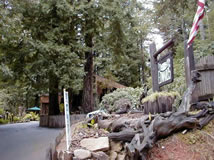 |
| View
from the street. The drive to the left goes to the
Carport. To the right of the redwoods, to a parking
place for one car. The house open to the street but
the view is protected by the redwood cluster. |
|
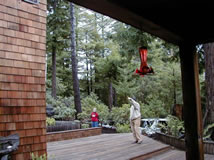 |
| View
from Carport looking at front deck. The redwood tree
cluster is to the right of the deck. |
|
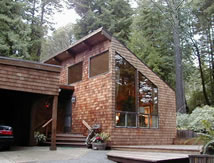 |
| View
from the driveway to front deck and Entry. The entry
needs better definition and a new door - perhaps a
trellis to better tie the Carport to it and create
a better transition from outside to inside. |
|
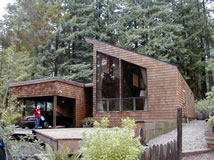 |
| View
from parking area to front deck and Living Room windows.
There is a water problem on this side of the house.
It may be a good option to extend the roof to better
shed onto the gravel area which is newly provided. |
|
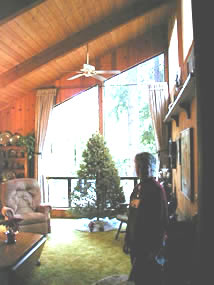 |
| View
from Entry into Living Room and out front windows.
Entry needs to better defined. A pellet wood stove
heats the house supplemented with electric baseboard
heating. The original carpet is to be replaced with
a new sub-floor and tile flooring. The drapes go to
be replaced with a shade system that comes up from
the floor. The front window faces South - the high
window West. The light into this room is bright on
a sunny day. |
|
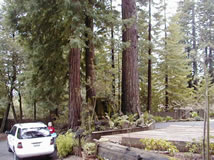 |
| View
from the Living Room outside corner looking at the front
deck, redwood tree cluster and parking area. |
|
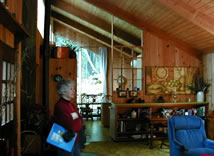 |
| View
from the south end of the Living Room looking at stove,
Entry and into Kitchen/Eating area. |
|
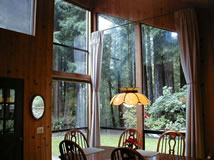 |
| View
from Kitchen area to Eating area and into back yard. |
|
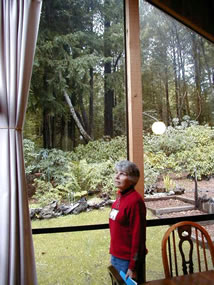 |
| View
Eating area window and view into back yard. |
|
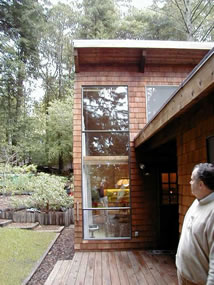 |
| View
from back deck at eating area. Bedroom and Bathroom
is at the right. The doors and windows from these
rooms require redoing. A great opportunity is being
lost here. This is Bill Brown the Broker who sold
us the house. If you want a home in the region e-mail
him @ wbbrown@quiknet.com - he does a very good job. |
|
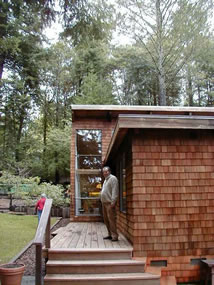 |
| View
from the west deck (the largest). The railing needs
a little help. |
|
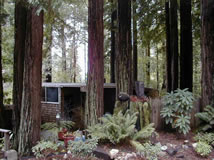 |
| View
from the west deck to the storage area. This will
be a great place for a hot tub. The building is on
the property line and most likely cannot be developed. |
|
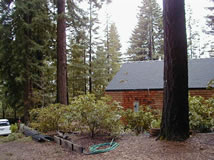 |
| View
from the second lot looking at the east side of the
house. This lot rises gradually, is well landscaped
and makes an ideal location for a Guest/Studio building. |
|
Photos
taken December 29th 2001
Our first visit to the property
|
|
|
This
is a nice simple house in a spectacular setting. There
has been some water and bug damage due to a couple
of design flaws that are easily rectified. This will
take somewhere in the 12 to $13,000 range. The next
task is to fix certain awkward design details, “clean
up” the look (install simple tile floors) and
let the basic purity of the design emerge. The East
wall of the Living Room requires built-ins for books
and simple pull down work stations. The back of the
house needs to be opened by modifying the walls looking
to the rear yard and connecting the Bedroom, Bath
and Kitchen/Eating area with a better glass fenestration.
A few trellises at the Entry and around the roof area
(which needs extending in a couple of key areas) will
complete the work. There is about $17,000 budgeted
for this work which is about the amount the seller’s
discounted infor damaged. When completed, this environment
(including two lots) will have a total cost and mortgage
at about a quarter of a million dollars - a very good
purchase in these times in California. Starting in
July and our final lease payment in Palo Alto, our
monthly cost-of-living will be reduced by almost half
while our living amenity is immeasurably increased.
|
|
This
restorative work and new detailing will net a simple
eloquent basic house comfortable to live in and structurally
stable for a long time. The landscape setting cannot
be repeated except the way that this was created:
years and years of careful work. It is difficult to
image, in California at this time, a nicer habitat
that can be purchased for the investment. The hidden
bonus, of course is the second lot which can be developed
to house a Guest/Studio - more space for us and a
place for family, friends and work associates.
|
|
After
the Phase I work is completed, the physical work for
the Guest/Studio can begin. This project, however,
will proceed on a cash basis and that will set the
schedule. I am working through the basic design NOW
- before completing Pahse I work on the main house
proceeds - because the intimate design detailing decisions
for the main house (trellises, doors, windows, etc.)
need to be made in reference to this latter addition
on the site. The “styles” will be different
but the two must be integrated and comfortable with
one another in terms of scale, texture, proportion
and some detailing. It is my intention that the Guest/Studio
will be built by Gail and me and SFIA student architects.
The Guest/Studio will be a small work with great attention
to detail. It must be economical and built with love
- it is an intimate piece. It is designed in
a way that supports (requires) prefabrication and
that allows the project to be realized on room (building
unit) at a time. This will be far more friendly to
cash flow than having to erect one big monolithic
structure. In addition, because the units are structurally
the same, the shop jigs and setups will produce a
lot of building for little cost.
|
|
Elsewhere
in May/June 2002
|
|
| The
first phase (Phase Ia) of work was completed between
our closing in February and moving in mid March. Basically,
this consisted of repair under the floor where there
was rot and bug damage, putting in crawl space ventilation
the lack of which caused the damage, leveling the subfloor
and laying a new rosewood floor to replace the carpet.
Drapes were removed and details cleaned up so that the
simple geometry of the building is revealed and the
view into the landscape is uncluttered. |
|
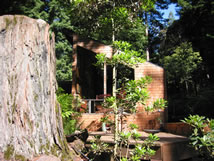 |
| In
the front there is a large cluster of redwoods that
have grown from the stump of a tree cut 100 years ago.
This is the focal point of the drive and parking areas. |
|
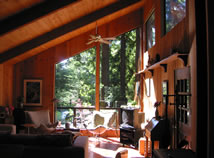 |
| Living
Room in early morning light. |
|
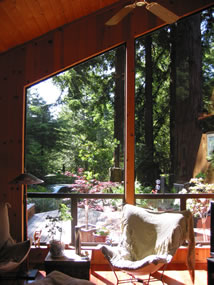 |
| The
front redwood cluster seen from the living room windows
across the front deck. The house sits about 10 feet
above the road which is about 30 feet on the other side
of the redwoods. |
|
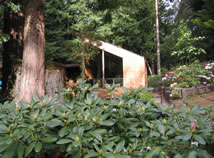 |
| Further
back and partially up the slope. The bare area is the
old logging path. Just to the right of this is where
the “Work” unit of the Guest-Studio will be
placed. |
|
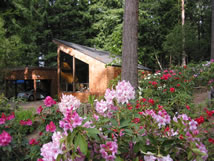 |
| Continuing
around counter clockwise, the rise becomes apparent. |
|
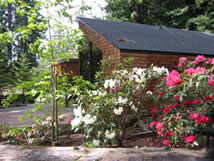 |
| Closer
in view of the corner and side of the house. |
|
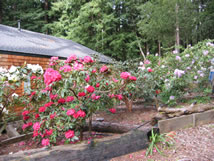 |
| View
from the logging path, called “skid row” by
the locals, across the planter to the side of the house.
The Work unit of the Guest Studio will sit here. |
|
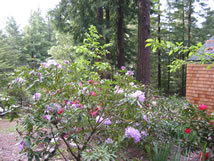 |
| looking
back at the front corner of the house and the redwood
cluster. “Skid Row” is to the immediate left.
It angles away from the house about 15 degrees. |
|
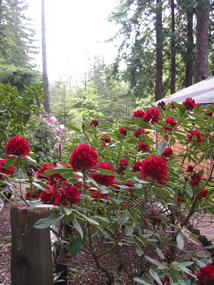 |
| View
from the future placement of the Eating unit of the
Guest-Studio. This is close by path to the Kitchen in
the existing house. |
|
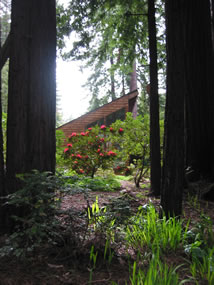 |
| Behind
the house looking into the Dining-Kitchen area. This
is the North property line behind which is several hundred
acres of watershed owned by the local family-run water
company. This land is likely to remain undeveloped for
a long time. |
|
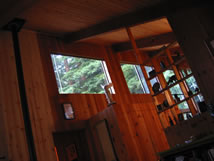 |
| Morning
view from the couch in the living Room looking toward
the Kitchen Dining area. |
|
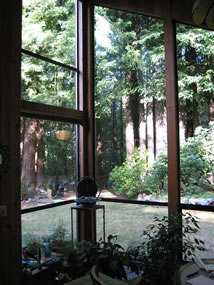 |
| View
to the back from the Dining Area a pleasant place all
day long with constantly changing light patterns. |
|
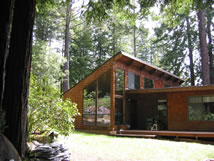 |
| Outside
the Dining Area (left) with the Bath and Bed Room to
the right. The recessed porch is the Bathroom wall which
we will open up in the Phase II work. |
|
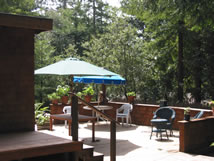 |
| Stepping
down from the rear porch looking to the SW Sun Deck. |
|
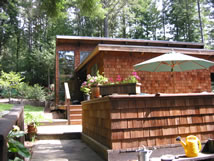 |
| The
quality of the light is the big surprise of this environment.
The Edwards spent years selectively cutting trees, pruning
and landscaping to get the light to work the way it
does. |
|
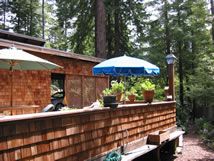 |
| The
raise deck show the excellent drainage on this side
of the house. It is good all around except for the Dining
area corner where water drains directly onto the house. |
|
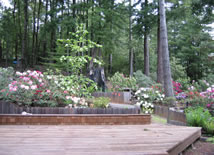 |
| Continuing
around to the front deck and up the slope where the
Guest-Studio units will be placed. |
|
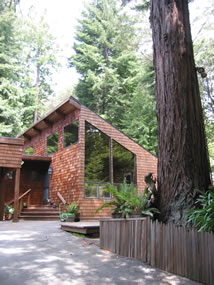 |
| Back
to the front on the left hand and roadside face of the
redwood cluster. The slope to the street is just beginning
from here. This is, of course, the first view of the
house when entering the driveway. |
|
guest_studio
Guest-Studio
Design
|
|
The
Schematic above layout shows some of the basic elements
of the Guest-Studio design. Each “room”
is a detached 12 foot by 12 foot glass cube. While
all of the rooms are designed to be adaptive to
several purposes, each one it also specially oriented
and equipped for a single prime function. In turn
they are: Work, Sleeping, Eating and Bathing. Each
room has it’s own 12 foot by 12 foot elevated
deck and the entire complex is tied together with
an elevated deck - partially covered with a trellis.
The site slopes downward from the Bath Room to the
Work Room. The main (existing) house is to the left
of the schematic plan. This area is actually an
old log path that ran one mile down from here down
to the sea when this area clear cut a 100 year ago.
In addition to the 4 functional rooms, a 12 foot
by 12 foot Utility Room will be built for energy
and water generation and storage.
|
|
A
requirement of the new structure is that the majority
of the work be done off site. Pieces have to be
pre-fabracated and carried to the building location
so as to not disturb the extensive landscaping -
the result of 20 years of work - already in place.
This, in fact, imposes no hardship because this
requirement has been incorporated as a basic design
premise of the concept. The real outer walls
and roofs of the 12 foot glass cubes will be the
landscaping and redwood tree canopy, as well as,
a few screens (turndowns of the trellises) placed
in strategic places. Landscape lighting will make
controllable cones of light around the units at
night allowing different degrees of natural transparency
and privacy. Shades, built into the mullions, will
provide acoustic, temperature and visual attenuation
on a panel by panel basis - both night and day.
The trellises are placed so as to provide sun attenuation,
shadows and a horizontal line emphasizing a strong
sense of shelter.
|
Guest-Studio
Unit Addition
Concept Sketches - June 29, 2002
|
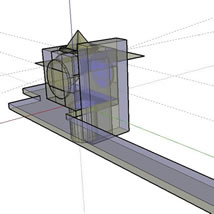 |
| Each
“room” is detached from the other.
One walks through the landscape to get from
room-to-room. |
|
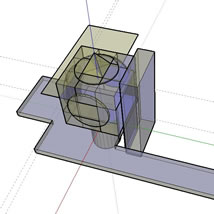 |
| The
main elements are: 12 foot glass cube, utility
core, deck, walkway, trellises and support tube
under the unit. The units cascade down from
the top. In some places, they will be close
to the ground and “deep” into the
landscaping. |
|
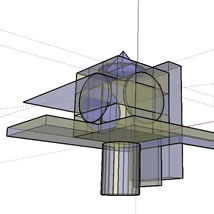 |
| At
other locations, units will “float”
above the site. This is determined by privacy
requirements, existing landscaping and providing
the right “massing” in relationship
to the existing structure. |
|
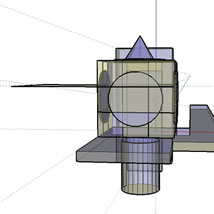 |
| The
glass wall are divided into 9 sections with
a superimposed circle oneach side. Inserted
into the center of this geometry, is an operational
window or door. |
|
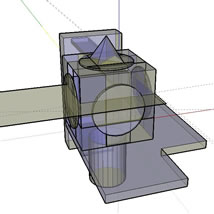 |
| The
main trellis is oriented to provide sun control
and appropriate privacy for the room. The crystal
“lantern” on top is a vent, natural
light controller augmented with 12 volt lights
for evening use. |
|
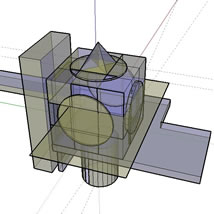 |
| Each
unit is a study in symmetry and asymmetry. Each
unit is basically the same with differences
determined by both its specific function and
site conditions. |
|
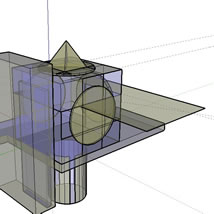 |
| The
composition is both serene and bold, structured
and flowing. The redwood trees and rhododendrons
are the “focus” of the rooms.
This landscape composes the real walls
of the environment. |
|
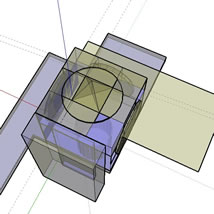 |
| This
is what Schinler called “transparent”
architecture. You see in and out, through and
around... Only the Utility Core is solid (shingles
to match the house). The units have strong presence
and they “disappear” into the
landscape. |
|
|
This
new structure is to be as energy and water independent
as possible. The goal is to be totally self-contained
at some point. This is THE major technical
design criteria and push of the project.
The existing building will be, technically, left
“as is” with any improvements to existing
technical systems made as and when possible. Intensive
food gardening will be added as time allows. The
goal is for two people to be be able to live here
for a total budget (food, tranportation,
entertainment - everything) of $40,000 a year. This
allows economic retirement on a little over a million
dollars equity base (depending on the investment
strategy). By choosing the timing well, this home-studio
is three hours of plesant driving to Palo Alto and
my other
interests. At present it is, for us, the best
buy possible in terms of cost and amenity trade-offs.
|
|
|
| The
vertical circular element below the center of each unit,
besides providing structural support, houses whatever
is necessary to support the process related to
the special function of the unit be that sleeping, eating,
working, bathing and so on. Appropriate devices fold
out of and store in this “tube” - the floor
can be flat or open to a bed, table, desk or tub as
is required. This way, the basic 12 by 12 footprint
is left free to the maximum degree and large pieces
of furniture that are used only intermittently do not
dominate the sense and other uses of the space. Neatness
is also facilitated because a “put-away” environment
is just easier to keep. One can think of these units
as “ships” - they are boat-like
in their use. They “dock” to the land but
they do not sprawl all over it as so many buildings
do. How structures sit upon the ground is a deign issue
too often neglected. |
|
|
| The
surrounding redwoods make the roof of the Guest-Studio
units. Flowering bushes make the walls. |
|
|
| The
canopy varies in height. Many of the trees are
10 to 15 stories tall - some taller. |
|
|
| The
existing lot has be carefully cultivated over
a 30 year period to create an unforced natural
landscape. The new structure must both respect
and add to this beauty. |
|
|
| The
setting for the Eating, Sleeping and Bathing units.
They will reflect the green in daytime and will
glow like lanterns at night. |
|
|
| The
land steps up from the North and East sides of
the house in plateaus created by small retaining
walls and fallen redwood logs. The total rise
is about 15 feet. |
|
|
| There
are blooms of various species nearly year round
with the majority of the activity in the spring.
This creates a sense of season even though the
California northwest ocean climate is very mild
year around. |
|
|
| Under
the units, the landscape will be lower plants,
bark and ground cover. The unit’s floor plane
will be glass from the outer edges back to the
large circular element providing maximum viewing. |
|
|
| The
result will be layers of pattern and color fusing
prospect and refuge changing minute by minute
day and night. |
|
|
|
Setting
a structure into the landscape and altering the landscape
to a building is one of the most intricate and most
neglected architectural design challenges. The Edwards
did an excellent job over a 30 year period. Far better
than most professionals ever do.
|
|
The
existing house is far from being a great work of architecture
although it commits few sins and follows many of the
Usonian, post-WWII ideals: small size, simple detailing,
natural materials, abundant glass looking into a well
crafted landscape. The orientation of the home to
the sun, its fit into the landscape, the many decks
for sitting and work, add up to a living ambiance
that could not be better. Anyone would be hard pressed
to improve it.
|
|
In
the case of the Guest-Studio building, there are three
key divers of the design: First, that the building
fits intimately with the landscape and employs,
predominately, the old logging path which still remains
mostly open and bare; Second, that issues related
to scale and grammatical fit between the existing
and new structure be handled with sensitivity; Third,
that the specific functions (eating, sleeping,
bathing, working, sitting, and so on), served by the
new environment, be individually singled out and highlighted.
Most houses blur these distinctions therefor
limiting the degree that each different experience
can be “raised
to the level of ART.” Think of these
units as temples to the act of doing - whatever
that process is - while maintaining a state of grace
and contemplation.
|
| In
the vast majority of modern work, the sensual is lost.
The FEEL of sunlight and water while talking
a bath in a flower garden is not common. Why? We moderns
are cluttered up with synthetic materials, synthetic
look, synthetic experience. The ORGANIC is lost
in the clutter. The mission of the Guest-Studio is to
provide a very clear alternative to this (lack of) modern
experience. Since this environment is designed for periodic
stays, it can make a strong statement in this regard.
This approach exemplifies many aspects of what resort
architecture should do in order to provide authentic
re-creation and re-connection (religion)
time. |
|
|
|
Work
Phase Ia:
Work
to be done includes plumbing for future floor heating
system. Spraying for wood preservation before covering
up. Replacing floor insulation before Fall. Augmenting
under house ventilation. Leveling the grade under
the house. Cutting doors for carpet clearance. Replacing
flooring damaged by refrigerator leak.
|
|
Work
Phase Ib:
Ideally,
to be completed in 2002.
|
Skylight
in Bedroom.
Roof
extensions and trellises. Roof water capture
and storage system.
Drainage
and waterproofing around stem walls - North
East and North sides.
Repair
rot and bug damage to North Wall structure (?)
and decks.
New
window shade system (wait a full season to see
if this is necessary).
Sleeping
- Reading Loft over utility closet.
Repair
windows. Modify/replace windows at Bed Room
and Bath opening to rear deck.
Replace
Entry door and back door to rear deck.
Organize
storage areas.
Built-ins
in Living Room.
Finish
Design Development of Guest/Studio buildings.
File for permits.
|
A
new Project (September/October 2002):
After
living in the house for 6 months it is clear that
Gail needs and “office” for her writing
and TomorrowMakers work. The desk in the Living Room
is not adequate, neither in space nor in privacy.
Over my last several stays home, I have been thinking
about this and about three other possibilities: using
the Bed Room/Carport roof for solar and a deer-protected
herb garden, and the possibility that we could see
the ocean from this roof. In September, the idea of
a vertical “nest,” “Tiffany lamp,”
“flower” off the West corner of the house
came to me. On October 1st. we climbed the roof which,
it turns out, offers a Zen view of the Ocean and sunset
and is also perfect for the other uses. On the 3rd,
I sketched the addition.
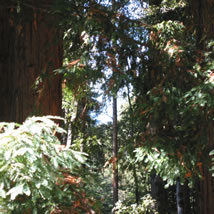 |
| A
Zen view from the West provides a sense
of the ocean a mile away - spectacular at
sunset, peaceful during the day.
The
addition is made of laminated wood, steel
and glass. The corner of the Bed Room is
replaced by a circular stairway to the roof
area encased in a wood base which flares
out to become a circular work area covered
by a translucent dome, steel and wood trellis.
Hand carved stantions embrace the house,
terminate the decks and support the structure
which rises like a flower - Tiffany lamp.
The work area directly faces the ocean view
which is 45 degrees Westward in relation
to the house.
The
landscape slopes away in all directions
from this side of the house enhancing the
sense of height while looking into the front,
side and back yard areas. |
|
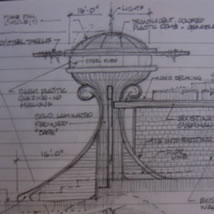 |
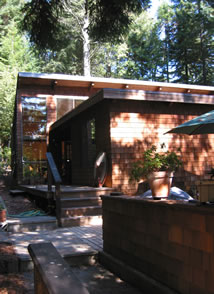 |
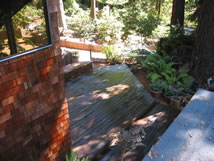 |
This
project will encompass several Phase 1b projects and
makes an excellent “stand alone” project that
can test out several ideas that SFIA Architects-MasterBulders
is interested in pursuing as part of our practice. For
several reasons, then, it makes sense to put this piece
on top of the priority list. Although it is an integral
part of developing the Elsewhere environment, because
of its unique architectural character I am listing it
as a separate
project.
Work
Phase Ic:
Ideally
to be completed in the Spring of 2003
|
Redo
of Bathroom - tile floor, sunken tub, Sauna
(on porch), glass wall and door to porch.
Install
floor heating system.
Replace
Kitchen counter tops and repair cabinets.
New
electrical service panels.
|
|
|
Work
Phase II:
Guest-Studio
Unit # 1 - Work - to be erected in October/November
2002 as proof-of-concept. No plumbing and temporary
electric heating. Remaining units and energy system
to be built throughout 2003. (note: with the development
of Gail’s Nest, the Guest-Studio project will
be deferred until afterward. The Nest is a more primary
project and we want to understand it’s impact
on the property before proceeding.
|
|
|
Guest
Studio - Unit 1 - July 4, 2002
|
|
|
Unit
#1 is the Work Room. It is the closest to the parking,
front deck and the house. The other Unites get progressively
further away (except Eating is close to the main house
Kitchen at the rear) and more private. The Guest Studio
is for Gail’s and my use, family and occasional
personal or business associate guest. This is not
being built to function as an active
client space or high activity work area. Other facilities
in the Bay
Area will serve these purposes.
|
| These
sketches were made during a 10 day stay at Elsewhere,
my longest period here to date. This is an extraordinary
home. A great PLACE to renew and rest while letting
new ideas work their way to the surface of the mind.
It is still here. There are many animals and birds.
A magnificent landscape. An active community a mile
away and the whole Northern California coast line. For
me, this is a place of retreat and rest from active
work - which my necessity is high activity and “public.”
For Gail, her home and space to think through and create
Tomorrow
Makers. Any work on Elsewhere is to create that
which will foster this sense of refuge, rest, study
and contemplation. |
|
Matt
Taylor
Palo Alto
January 4, 2002
|
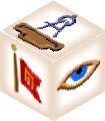
SolutionBox
voice of this document:
VISION • STRATEGY • SCHEMATIC
|
posted
January 4, 2002
revised
October 3, 2002
• 20020104.848801.mt • 20020106.555591.mt
• 20020110.452988.mt •
• 20020701.398871.mt •
20020703.222200.mt • 20020704.914238.mt •
• 20020707.555511.mt •
20021003.659233.mt •
(note:
this document is about 80% finished)
Matt
Taylor 650 814 1192
me@matttaylor.com
Copyright©
Matt Taylor 2002
|